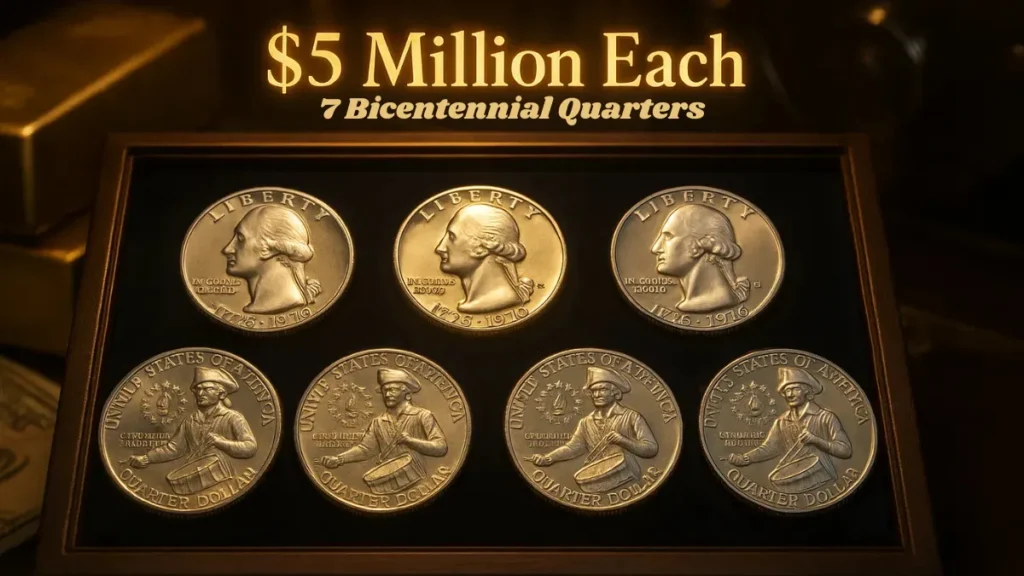Could Your 1976 Bicentennial Quarter Be Worth Over $5 Million? Here’s What You Need to Know
The 1976 Bicentennial Quarter isn’t just a tribute to America’s 200th birthday—it could also be a hidden windfall. While the vast majority of these coins are only worth their face value, a few ultra-rare versions have stunned collectors by selling for more than $5 million due to rare mint errors and special compositions.
This guide reveals what makes some Bicentennial Quarters incredibly valuable, how to identify one, and where to sell it if you think you’ve struck gold.
7 Rare Bicentennial Quarters Worth Over $5 Million
Although millions were minted, only a select few Bicentennial Quarters are rare enough to command sky-high prices. These coins are prized not just for their historical value but for unique features that make them standout collector’s items.
Here’s what collectors and investors pay attention to:
- Why are some worth millions?
Rare mint errors, silver content, and high-grade condition add major value. - Key identifiers
Look for error types, uncommon mint marks, and silver compositions. - Where were they minted?
- No mint mark: Philadelphia
- D mark: Denver
- S mark: San Francisco (usually proofs or silver)
- How to assess value
Examine for errors, weigh the coin, and have it professionally graded. - Where to sell
Use auction houses, verified dealers, or trusted marketplaces. - Helpful resources
Check the official U.S. Mint website for specifications and guides.
What Makes These Quarters So Valuable?
While most Bicentennial Quarters are regular circulation coins, a few possess traits that dramatically increase their worth.
1. Mint Errors
Mistakes during production can turn an ordinary coin into a rare gem. The most sought-after include:
- Double Die Obverse – visible doubling in the text or design
- Off-Center Strikes – parts of the design misaligned
- Wrong Planchet Strikes – quarter designs stamped on blanks for other coins like nickels or half dollars
2. Silver Content
Some special collector’s sets from 1976 contain 40% silver quarters. These coins, especially when in proof condition or combined with mint errors, are significantly more valuable than regular copper-nickel versions.
3. High-Grade Condition (MS-67 or Above)
Coins graded Mint State 67 or higher by reputable services like PCGS or NGC are rare and often bring in serious money—sometimes even millions, particularly when combined with other rare features.
How to Identify a $5 Million Bicentennial Quarter
Think you’ve got a jackpot in your coin jar? Follow these steps to investigate:
Step 1: Check the Mint Mark
- No mark = Philadelphia
- D = Denver
- S = San Francisco (likely silver or proof)
Step 2: Look for Minting Errors
Use a magnifying glass to examine fine details. Look for:
- Doubling in letters or numbers
- Design elements that are off-center or missing
- Unusual textures or shapes
Step 3: Determine the Metal Composition
- Regular quarters weigh about 5.67 grams
- Silver quarters weigh around 5.75 grams
- Look at the coin’s edge—silver quarters don’t have a visible copper strip
Step 4: Get the Coin Professionally Graded
Submit your coin to PCGS or NGC. A high grade, especially MS-67 or better, can skyrocket its market value.
Step 5: Compare Market Prices
Research recent auction sales and online listings to gauge how much similar coins are selling for. Use platforms like Heritage Auctions or eBay to check current demand.
Where to Sell Your Rare Bicentennial Quarter
If your coin fits the bill, here are your best selling options:
- Certified Coin Dealers – Get a formal appraisal and competitive offers.
- Major Auction Houses – Try Heritage Auctions, Stack’s Bowers, or similar names for maximum reach and returns.
- Online Platforms – eBay and Etsy can attract collectors, but always be alert for potential scams.
- Local Coin Shops – Quick and easy sales, though prices may be lower than at auction.
FAQs About Rare Bicentennial Quarters
Q1: Are all Bicentennial Quarters valuable?
No. Most are still worth just 25 cents, but rare versions with errors or silver content can be worth thousands—or millions.
Q2: How can I tell if mine is silver?
Silver quarters weigh a bit more and have a solid silver edge without the copper stripe found on clad coins.
Q3: What’s the highest price ever paid for one?
More than $5 million was paid for an ultra-rare proof error version of the 1976 Bicentennial Quarter.
Q4: Can I find a rare one in everyday change?
It’s unlikely but not impossible. While most are in private collections, some valuable ones still pop up unexpectedly.
Q5: Should I clean my coin before trying to sell it?
Never clean a coin. It can damage the surface and drastically reduce its value. Always leave it in its original condition.
Final Thoughts
While it’s true that most Bicentennial Quarters are common, the rare few with mint errors, silver composition, or pristine grades could be worth a fortune. Take a closer look at your pocket change—you might just be holding a multi-million dollar piece of American history.
If you think you’ve found a standout, have it graded, do your research, and choose the right platform to sell. The right quarter could change your financial future.
You have not enough Humanizer words left. Upgrade your Surfer plan.

